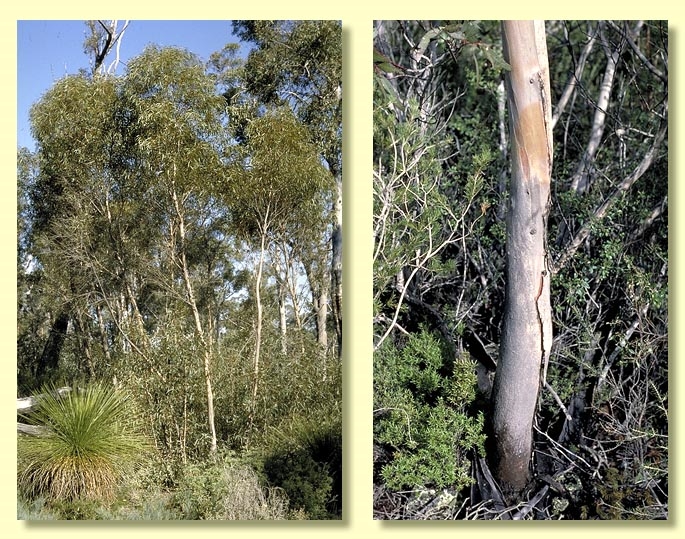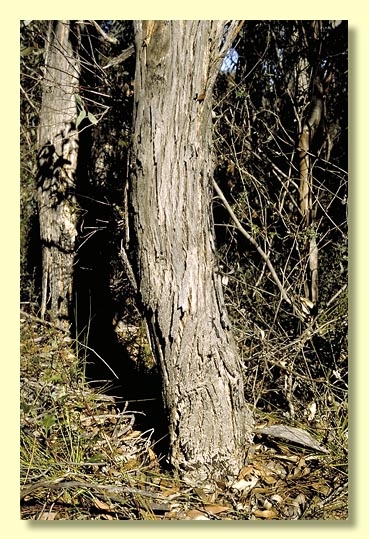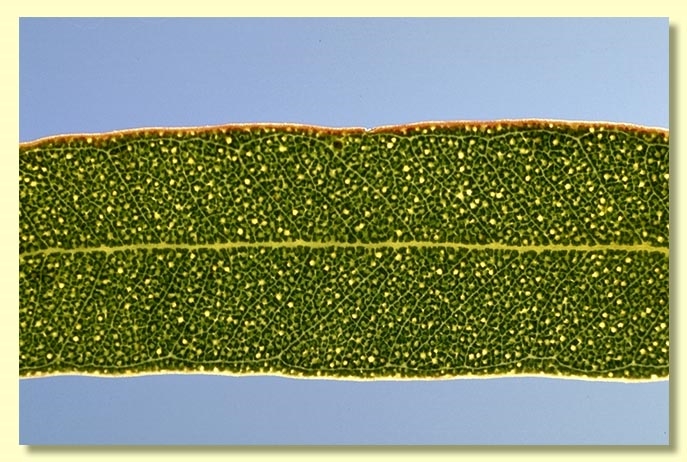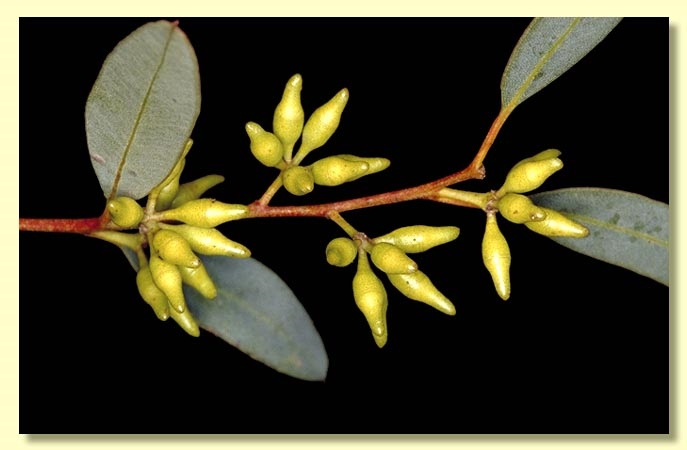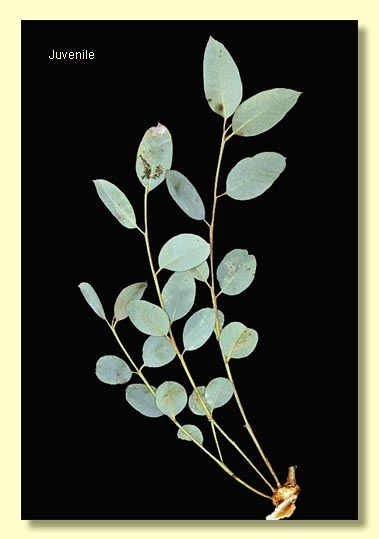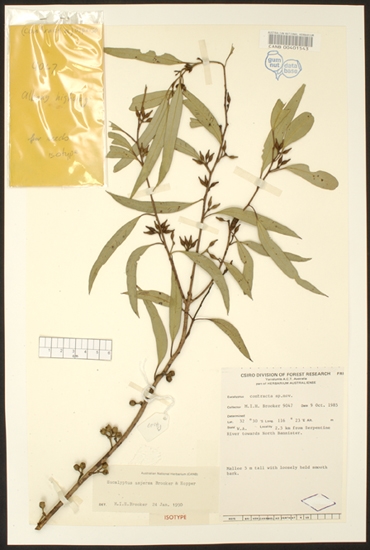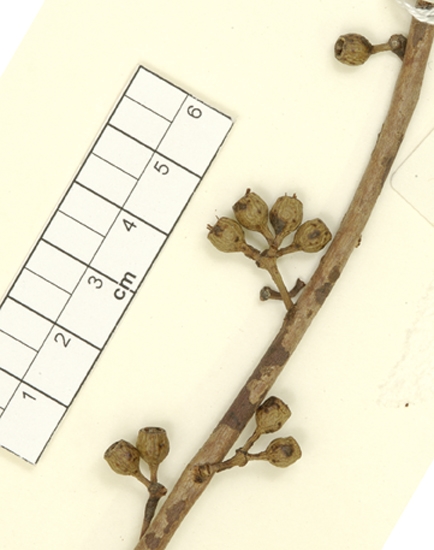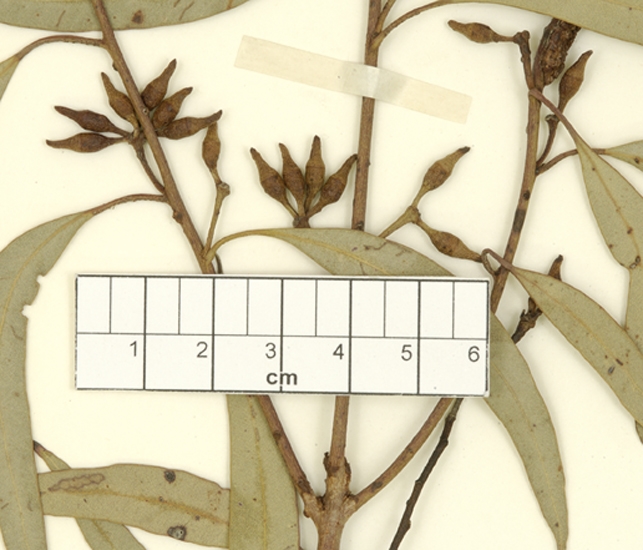Eucalyptus | Symphyomyrtus | Bisectae | Destitutae | Subulatae | Decussatae
Euclid - Online edition
Eucalyptus aspersa
Bark usually rough over most of the stems, flaky or fibrous, usually held in loose slabs, light grey to yellowish-brown, rarely almost smooth-barked.
Branchlets lacking oil glands in the pith.
Juvenile growth (coppice or field seedlings to 50 cm): stems square to rounded in cross-section; juvenile leaves alternate, shortly petiolate, elliptical to ovate, 2–7.5 cm long, 1.4–3 cm wide, bluish green.
Adult leaves alternate, petiole 0.5–2 cm long; blade narrowly lanceolate to lanceolate, occasionally falcate, (4.5)5.5–12 cm long, (0.8)1–2 cm wide, base tapering to petiole, concolorous, slightly glossy (rarely dull), light green, side-veins at an acute or wider angle to midrib, moderately to densely reticulate, intramarginal vein parallel to and just within margin, oil glands mostly intersectional.
Inflorescence axillary unbranched, peduncles 0.5–1.2 cm long, buds more than 7 per umbel, pedicels 0.2–0.4 cm long. Mature buds narrowly ovoid (0.8–1.1 cm long, 0.3–0.4 cm wide), scar present, operculum beaked (0.5–0.8 cm long), stamens irregularly flexed or rarely inflexed, anthers weakly versatile or adnate, basifixed, globoid, dehiscing by lateral pores, style long, stigma tapered, locules 3 or 4, the placentae each with 4 vertical ovule rows. Flowers white.
Fruit pedicellate (pedicels 0.2–0.3 cm long), usually urceolate, occasionally truncate-globose to cup-shaped, 0.4–0.8 cm long, 0.4–0.7 cm wide, disc descending, valves 3 or 4, valve tips strongly exserted due to fragile style remnants.
Seeds brown or grey, 0.9–1.1 mm long, ovoid or flattened-ovoid, occasionally with shallow longitudinal furrows on otherwise smooth dorsal surface, hilum ventral.
Cultivated seedlings (measured at node 10): cotyledons Y-shaped (bisected); stems square in cross-section; leaves opposite, sessile and linear for the first 5 or 6 nodes then alternate, shortly petiolate and becoming elliptical to ovate further up the stem, 2–4 cm long, 0.8–2 cm wide, dull green.
Flowering time unknown.
A mallee occurring in small, pure stands scattered in the jarrah forest south-east of Perth, Western Australia, from Boyup Brook and south of Kojonup to Narrogin and North Bannister extending further north to Boomer Hill. The bark is usually rough and loosely held in flakes or ribbons but occasionally can be almost smooth. The adult leaves are light green and slightly glossy. The seedling leaves become petiolate early in the development of the seedling.
Eucalyptus aspersa belongs in Eucalyptus subgenus Symphyomyrtus section Bisectae subsection Destitutae because buds have two opercula, cotyledons are Y-shaped and branchlets lack oil glands in the pith. Within this subsection E. aspersa is part of the large taxonomic series Subulatae further characterised by globoid basifixed anthers, grey smooth seeds with shallow longitudinal furrows, and fruit with persistent exserted style remnants. Series Subulatae is divided principally into four subseries based on the juvenile leaves, one with spiral, crowded seedling phyllotaxis (subseries Spirales), another with decussate and decurrent seedling leaves (subseries Decurrentes), another with decussate non-decurrent seedling leaves (subseries Decussatae), and a fourth with alternate (disjunct), petiolate seedling leaves (subseries Oleaginae).
E. aspersa is part of subseries Decussatae, based on the ovate to elliptic, shortly petiolate juvenile leaves that soon become alternate at an early stage of development. Within this group, E. aspersa is closest to E. socialis subsp. socialis. Both are weakly separated by the early development of petioles in the seedling leaves of E. aspersa (seedling leaves of E. aspersa usually petiolate by node 10, seedling leaves in E. socialis usually sessile until after node 20).
Occasional hybrids are found between E. aspersa nad E. dorrienii (series Falcatae) where these two species co-occur. The hybrid plants were formally named by Johnson & Hill (1999) as Eucalyptus X intrasilvatica.

